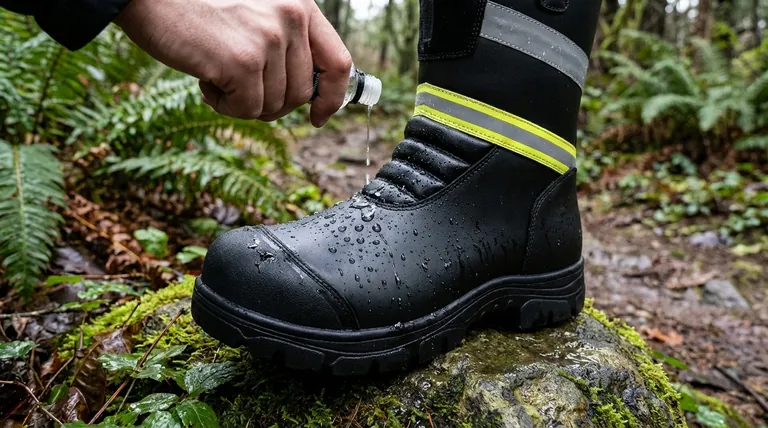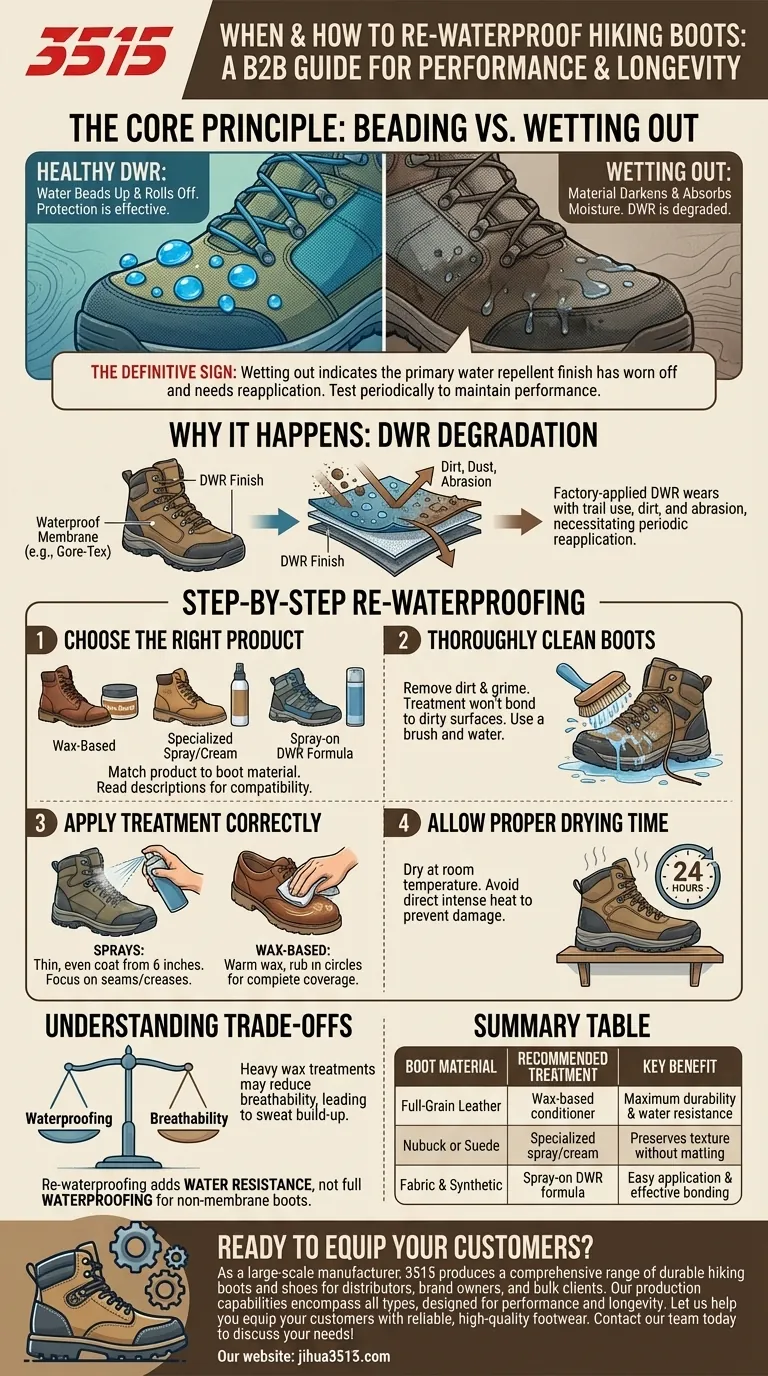The definitive sign that your hiking boots need waterproofing is when water stops beading up and rolling off the surface. Instead, you'll see the outer material darken as it absorbs moisture, a phenomenon known as "wetting out." This indicates the boot's primary water repellent finish has worn off and needs to be reapplied.
The core principle is simple: your boots' factory-applied water repellent is a finish that degrades with use. You must test your boots periodically and reapply a treatment to maintain their performance, protect the materials, and ensure your feet stay dry.

The Core Principle: Beading vs. Wetting Out
The most reliable indicator for re-waterproofing is a simple visual test. Understanding what you're looking for is the first step in proper boot maintenance.
Identifying the Telltale Sign
The test is straightforward: sprinkle a few drops of water onto the boot's surface. If the water forms tight beads and rolls off easily, your Durable Water Repellent (DWR) coating is still effective.
If the water sinks in, spreads out, and darkens the material, the boot is "wetting out." This is your clear signal that it's time to re-waterproof.
Why This Happens: Understanding DWR
Most waterproof boots have two lines of defense. The first is an internal waterproof membrane (like Gore-Tex). The second, and the one you maintain, is the DWR finish on the exterior fabric or leather.
This outer DWR coating is designed to shed water and prevent the boot's material from becoming saturated. Dirt, dust, and abrasion from trail use wear this coating down over time, which is why periodic reapplication is essential.
A Step-by-Step Guide to Re-Waterproofing
Once you've determined your boots need treatment, following a precise process ensures the best results. Rushing these steps can lead to an ineffective application.
Step 1: Choose the Right Product for Your Material
The type of boot you own dictates the product you must use. Applying the wrong treatment can damage the material or simply not work.
- Full-Grain Leather: Responds best to wax-based treatments, which offer heavy-duty conditioning and water resistance.
- Nubuck or Suede: Requires specialized sprays or creams designed to maintain the napped texture without matting it down.
- Fabric and Synthetic: Best treated with spray-on DWR formulas that are easy to apply and bond well with synthetic fibers.
Always read the product description carefully to ensure it's compatible with your boot's specific materials.
Step 2: Thoroughly Clean Your Boots
Never apply a waterproofing treatment to dirty boots. Dirt and grime block the treatment from properly bonding with the boot's surface, rendering it ineffective.
Remove laces, then use a boot brush and water to scrub away all mud and debris. A specialized boot cleaner can help remove stubborn oils and stains.
Step 3: Apply the Treatment Correctly
Application methods vary by product type.
For sprays, hold the can about six inches from the boot and apply a thin, even coat. Pay close attention to seams, creases, and around hardware like lace eyelets, as these are common leak points.
For wax-based treatments, it can be helpful to gently warm the wax with a hair dryer before application. Use a cloth to rub a small amount into the leather in a circular motion, ensuring complete coverage.
Step 4: Allow Proper Drying Time
After application, let your boots dry naturally at room temperature for at least 24 hours. Avoid using direct heat sources like a campfire or radiator, as intense heat can damage adhesives and cause leather to crack.
Understanding the Trade-offs
Re-waterproofing is not a perfect science. It's a balance between protection and performance, and it's important to know the limitations.
Waterproofing vs. Breathability
While an internal membrane like Gore-Tex allows vapor to escape, the DWR finish you apply can impact this. Heavy wax treatments, while excellent for water resistance on leather, can significantly reduce a boot's breathability. This can lead to sweat build-up inside the boot on warm days.
The Myth of "Making" Boots Waterproof
Applying a DWR treatment does not make a non-waterproof boot fully waterproof. It adds a high degree of water resistance.
For a boot to be truly waterproof, it must have an internal waterproof bootie or membrane. External treatments are designed to maintain the performance of these systems or to add weather protection to boots without them.
Making the Right Choice for Your Gear
Your approach should match your equipment and your goals.
- If your primary focus is maximum water resistance for full-grain leather: Use a robust, wax-based conditioner for the best durability and protection.
- If your primary focus is preserving the look of suede or nubuck: Choose a silicone-based spray specifically formulated for these materials to avoid discoloration.
- If your primary focus is a quick treatment for fabric or mixed-material boots: A simple pump or aerosol DWR spray is the most efficient and effective option.
Proactive gear maintenance is the key to ensuring comfort and performance on any trail.
Summary Table:
| Boot Material | Recommended Treatment | Key Benefit |
|---|---|---|
| Full-Grain Leather | Wax-based conditioner | Maximum durability & water resistance |
| Nubuck or Suede | Specialized spray/cream | Preserves texture without matting |
| Fabric & Synthetic | Spray-on DWR formula | Easy application & effective bonding |
Ready to protect your gear? As a large-scale manufacturer, 3515 produces a comprehensive range of durable footwear for distributors, brand owners, and bulk clients. Our production capabilities encompass all types of hiking boots and shoes designed for performance and longevity. Let us help you equip your customers with reliable, high-quality footwear. Contact our team today to discuss your needs!
Visual Guide

Related Products
- High Performance Fire-Retardant Waterproof Safety Boots
- Durable Waterproof Rain Boots | Custom Manufacturer for Wholesale & Brands
- Factory-Direct Wholesale Canvas Boots with High-Traction Rubber Soles
- Premium Wholesale Waterproof Safety Boots High Performance Protection for Industrial Markets
- Factory Direct Wholesale Rain Boots Durable Waterproof & Fully Customizable
People Also Ask
- How should one choose between steel toe and composite toe shoes? Match Your Work Hazards for Optimal Safety
- What are the different types of materials used in the toe portion of safety toe work boots? A Guide to Steel, Alloy & Composite
- What are the main types of safety-toe boots? Choose the Right Protection for Your Job
- Which industries commonly use steel toe boots? Essential Foot Protection for High-Risk Jobs
- What factors should be considered when choosing between steel and composite toe caps? Ensure Maximum Safety and Comfort



















